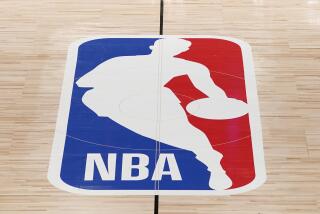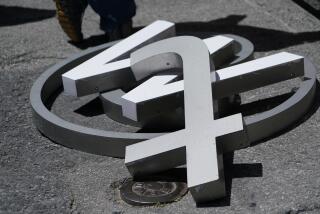IMAGE : Corporations in Search of an Identity Turn to Outside Consultants for Help : A New Look Can Reshape Perception
NEW YORK — When Sun Oil decided to diversify in 1976, the company dropped “Oil” from its name and refashioned its corporate symbol into a yellow sphere that one executive calls “the fried egg logo.” Then it told its 15 subsidiaries to create their own images, using whatever graphic designs or symbols struck their fancy.
Three years later, Sun had a mess on its hands. A patchwork of uncoordinated symbols and designs on signs, business cards and stationary had created a dizzying image akin to that of an executive whose wardrobe consists of plaid pants, checkered shirts and argyle socks. Employees didn’t know how the company’s parts went together. Neither did Wall Street.
“Analysts found the corporate picture we sent out confusing and wondered if the reality behind the presentation might be confused, too,” says Kurt Van Vlandren, Sun’s director of public relations and advertising. “Some said the perception was even keeping our stock price down.” To unite the company under one corporate banner, Sun sought help from the New York firm of Anspach, Grossman & Portugal, one of several dozen consulting firms nationwide that specialize in a growing marketing niche known as corporate image making.
Sun is hardly alone. In recent years, deregulation, changing technology and a slew of mergers and divestitures within industries such as oil, banking and consumer products have forced thousands of companies to compare their self-image with how the public views them. Many have turned to image specialists for guidance.
Recasting a corporation’s image may entail changes in its name, symbol or package or retail office design. But image makers insist that these are only the outward, creative manifestations of a grueling process that often requires soul-searching on the part of company executives and employees. Out of that process comes a decision about how the company wants itself to be perceived.
Corporate image makers say their craft has been around since man first hung out a shingle. But as a discipline separate and distinct from advertising and industrial design, corporate identity came into its own in the 1960s and 1970s. During those years, diversification and acquisition became dominant philosophies in many industries, causing companies to change the image they wanted to project to key audiences such as consumers, advertisers, suppliers, investors and government regulators.
Today, however, many companies are paring back their far-flung operations and concentrating more on those they know best. More than ever, corporate image makers--which in effect act as corporate psychiatrists--are in demand to examine companies’ personalities and help establish a strategy to sell their image to the right people, just as they might sell financial services, mops or gasoline.
“The business environment will always change and companies will always have to re-think who they are and how they are perceived,” says Tim King at Siegel & Gale, a corporate image firm in New York. Time Inc. has hired the firm to evaluate its “personality” after Time realized that it had no unifying symbol among its various divisions, which include publishing, cable-TV and even the Book-of-the-Month Club.
At Sun, the process of redefining its corporate image helped lead to the replacement of its diversification strategy with one that positioned the company squarely as an energy concern. The hodgepodge of symbols, including the “fried egg,” were replaced with one logo showing a sun’s rays bursting through the Sun lettering. The redesign was so well received that in 1983 Time magazine named it the most successful and aesthetically pleasing corporate symbol of the year.
“The entire process was like therapy,” Sun’s Van Vlandren says. “It got so intense that there were times people wanted to kill each other. But it was worth it. We’re happy with the change.”
The cost of employing a corporate image consultant and implementing the changes can range from $25,000 to several million dollars. Exxon’s name change from Standard Oil of New Jersey in 1972 reportedly cost the company as much as $100 million.
Not everyone thinks every change is worth the effort and money it takes, however. Advertising Age co-owner and columnist Rance Crain, for example, calls Consolidated Foods’ recent decision to change its name to Sarah Lee, one of the conglomerate’s leading brands, “a dumb idea.” Consolidated undertook the change because research showed that its name meant nothing in the minds of consumers while its Sarah Lee brand name was well-known and strongly associated with quality.
Unconvinced, Crain says he finds the new name odd for a consumer products company that also make Hanes hosiery, Bali bras, Hillshire Farm sausage and Electrolux vacuum cleaners.
Objects to Name
He and others also have objected to Nynex, the name New England Telephone chose for the independent entity it became when divested from AT&T.; “Nynex sounds as though it makes foundation garments or panty hose,” one analyst told Manning, Selvage & Lee, a public relations firm in New York that recently polled 75 securities analysts about corporate names.
Others point out that Kodak, Apple and Coca Cola, which are among the most successful corporate names, were thought up without Madison Avenue’s help by founders or top executives at the companies.
Even so, the array of goods competing for the attention of investors and consumers is growing, as is the complexity of the companies that sell them. This makes a company’s ability to communicate what it does and why it is different more crucial and more difficult, and it makes the role of consultants more important.
Not only do image specialists from outside provide objectivity, but they can help a client understand why a name like Calpis, a Japanese soft drink, might sell better under another name in English-speaking countries, or why General Motor’s Nova car might not sell well under that name in a Spanish-speaking country because it translates literally as “no go.”
Outside advice might have spared the public from having to work with MBPXL, a company name concocted in 1974 by directors of the then newly merged Missouri Beef Packers and Kansas Beef Industries. The name comes from the initials of Missouri Beef Packers and the XL brand name of Kansas Beef Industries. But to New York business consultant Joseph Mancuso, MBPXL “looks more like a printers error” than a name. The name was changed to Excel, but not until 1982. “And what a relief it was,” one Excel secretary says.
Can Sway Investors
Manning, Selvage & Lee says its research indicates that “a company’s name can influence an individual investor’s decision to buy or sell common stock and (therefore) directly influence its price earnings ratio,” a measure of the market’s future expectation of the company’s profits. But although a name often is the public’s first contact with a company, a simple, memorable title is not enough. Image makers, companies and advertisers agree it must reflect a larger game plan.
While the goal of communicating clearly to the public may be the same, the motivation to revamp an image varies from company to company. In 1982, for example, Tampax Inc. decided it no longer wanted to be a one-product company and would diversify within the consumer product market. Lippincott & Margulies Inc., a New York corporate identity firm, found that the Long Island, N.Y.-based company had the opposite problem from the one that had faced Consolidated Foods. Tampax, both a company and brand name, was so well known that people often misused it as a generic term for all tampons.
“The Tampax brand name had become a part of the personal hygiene vocabulary of generations of American women,” Lippincott & Margulies found. Although a valuable asset, the name would hamper the company’s efforts to branch out into pregnancy diagnostic tests and other drug store products. It also found that Tampax employees were embarrassed to say they worked for a company that makes feminine hygiene products, even though they were proud of the quality of the company’s product.
Lippincott & Margulies’ solution was to rename the company Tambrands Inc., retaining part of the old name and, hopefully, its connotation of quality, but leaving the name Tampax as the brand name of a specific product line. The company adopted the change in 1984.
Retailers Changing
One of the fastest growing areas of corporate identity consulting involves revamping retail outlet images, such as fast-food stores or airline waiting rooms.
Pepsico recently asked S&0, a corporate identity firm in San Francisco, for help in repositioning its Taco Bell food chain within the fast-food market. To attract more mainstream fast-food customers, Pepsico planned to expand the chain’s Mexican food menu to include salads and hamburgers. To reflect the change, S&O; redesigned the Taco Bell building, downplaying its Mexican motif.
Executives at Jack-in-the-Box had a slightly different problem. They had decided they wanted to cater to adult fast-food eaters. S&O;’s research showed that the Jack-the-Box name conjured up images of “screaming children” because the name is the same as a child’s toy.
“Lots of adults wouldn’t even consider going inside,” says Bill Schneider, an S&O; senior vice president. So the company has decided to test a new name, Monterey Jack’s, and a new graphic design. The new name will be test marketed soon in several states, including California, by the end of the year.
A key aim of any corporate image is to make a company seem “trustworthy and believable,” says Siegel & Gale’s King. Using the recent acquisition announcement of grocery food giant Nabisco by cigarette king R. J. Reynolds as an example, he says that while the combined concern’s products are all consumer goods, “it’s now a tobacco company that makes Fig Newtons and it’ll have to explain that to everyone from investors to consumers like you and me.”
Lengthy Studies
A study of the corporate identity of a large company such as Time or Reynolds usually requires hundreds of hours of interviews with employees, analysts, congressmen and the media to find out how the company rates with those in a position to influence its future. But even when a company knows that it wants to change, as Pepsico did with Taco Bell, research is required to translate the company’s general idea into specific ones that designers can turn into shapes, colors, brick and stone.
Advertising agencies as a rule are not in the corporate identity business, and ad campaigns are usually conceived after a company’s new image has been designed.
One exception, however, was the campaign designed by the ad firm of Earle Palmer Brown of Bethesda, Md., for the Big Boy hamburger chain. In a widely advertised “election,” the chain earlier this year asked customers to vote whether to keep or get rid of its long-time mascot, a pudgy, pompadoured boy. Customers voted overwhelmingly to keep the Big Boy.
Pressure from consumers also can force a change, as Procter & Gamble learned when it recently took its 100-year-old stars-and-man-in-the-moon logo off its products after unsuccessfully trying to scotch rumors that the logo somehow linked the company to satanic cults.
As in children’s names, image fads also come and go. With the diversification mania of the 1960s and 1970s, companies tended to want neutral names that would not conjure up any specific business. That way a corporation could buy and sell companies without having to change its image each time. That was the rationale when Swift & Co., long associated with meat packing, changed its name to Esmark nearly 10 years ago. Now the company has come full circle.
Last year Esmark was acquired by Beatrice, which has abandoned a similar strategy of anonymity for one that adds a “We’re Beatrice” signature after TV and print ads for everything from the conglomerate’s Samsonite luggage to La Choy food line. The aim is to link the Beatrice name with quality goods in the public’s mind so that new products from the conglomerate eventually will require less advertising to win consumers’ trust and acceptance.
Reflect Needed Face Lift
Corporate identity changes can reflect a needed face lift, as was the case recently with women’s clothes retailers such as Bonwit Teller and J. C. Penney. Or it can herald a new age for an industry.
AT&T;, for example, turned to Los Angeles corporate image maker Saul Bass to come up with the blue globe it now uses as its corporate logo in place of the familiar Bell System logo. The new logo, which shows microchip-like dots wrapping around a globe, symbolizes AT&T;’s metamorphosis from a long-distance telephone company to a provider of information services.
Nearly 10 years earlier, New York’s National City Bank took a similar step by changing its name to Citibank.
Walter Wriston, who stepped down as Citicorp chairman last year after earning the reputation for having the foresight to see that banking would merge with information and financial services, personally oversaw the name change.
It was meant to show that Citibank and its holding company, Citicorp, intended to lead the way in retail financial services. “You can’t sell Coke with a seven word name,” Wriston says of the decision to use the bank’s longstanding nickname as its formal title.
NUMBER OF FIRMS CHANGING THEIR NAMES
1984 871 1983 1,055 1982 809 1981 572 1980 422
NAME CHANGES BY INDUSTRIAL GROUPS
Banks, Thrifts and Other 379 Financial Institutions Manufacturing and Industrial 135 Energy 66 High Technology 45 Food, including Fast Food 44 Communications 37 Transportation 27 Retailing 19 Miscellaneous 119
More to Read
Inside the business of entertainment
The Wide Shot brings you news, analysis and insights on everything from streaming wars to production — and what it all means for the future.
You may occasionally receive promotional content from the Los Angeles Times.










